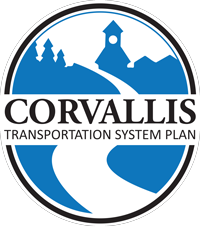Project Information
The Transportation System Plan (TSP) is a long‐range document that guides the expansion and management of our transportation network for all modes of travel over the next 20 years. In conjunction with the TSP update, the City will develop a Transit Development Plan (TDP), which will inform investment in the Corvallis public transportation system. A final TSP document will be completed in the spring of 2017.
The project team is seeking public input on draft goals and objectives for these two planning efforts which will ensure the plans are in alignment with community values. The draft project goals are by design narrowly focused on transportation. Currently, other community planning and visioning efforts are addressing broader goal areas.
Survey Sections
The following goals were drafted based on a review of other important community and regional planning documents and the TSP/TDP Steering Committee feedback. Under each of the goals is a list of potential strategies for achieving the goals, provided by the Steering Committee.
The project team will use the results of this survey to refine the draft goals, which will then be forwarded to the City Council for approval. After that, the project team will finalize the goals, develop a consistent set of objectives and align them with performance measures to evaluate draft solutions for future transportation improvements.
Goal 1 - Economic Vitality
Provide an efficient transportation system that supports economic vitality by facilitating the local and regional movement of people and goods.
Initial strategies for achieving the goal:
- Reduce miles of travel and travel time through improved connectivity where “barriers” exist (such as 99W,US 20, OR34, railroads, waterways, and neighborhoods).
- Maintain acceptable roadway and intersection operations where feasible considering environmental, land use, and topographical factors.
- Improve walking downtown.
- Improve north/ south and east/ west street connectivity.
- Provide efficient freight movement on regional travel routes.
- Increase the accessibility of major employment centers.
- Implement parking strategies that improve parking availability for businesses.
Read other comments...
Goal 2 - Health and Safety
Provide a transportation system that enhances the health and safety of residents.
Initial strategies for achieving the goal:
- Improve safety at locations with known safety issues.
- Minimize conflict points along high volume and/or high speed corridors.
- Support vibrant public spaces, and encourage a culture of walking, cycling, and social interaction.
- Expand the sidewalk, bike lane, and multi-use path network in the city.
- Implement safety enhancements along walking and biking routes to schools.
- Reduce traffic-related fatalities and serious injury collisions.
- Reduce the amount of collisions involving pedestrians and cyclists.
- Improve personal security (e.g., street lighting, surveillance/patrols around transit).
- Enhance travel options along seismic lifeline and other emergency response routes.
Read other comments...
Goal 3 - Diversity and Accessibility
Provide a diversified and accessible transportation system that ensures mobility for all members of the community and provides viable alternatives to automobile travel.
Initial strategies for achieving the goal:
- Increase transit ridership by improving the quality of available transit service as measured by coverage, hours of service and frequency.
- Develop bicycle and pedestrian facilities that encourage non-vehicular travel.
- Provide direct off-roadway pedestrian and bicycle routes and connections where obtaining right-of-way is feasible.
- Maintain and support the Corvallis airport as a regional facility.
- Allow for alternative transportation facility designs in constrained areas to minimize impacts to natural resources.
- Encourage comprehensive on-site TDM programs - including incentives and disincentives – by major employers & educational institutions.
- Make it easy for people of all ages and abilities to get where they need to go, comfortably and safely.
- Provide inexpensive transportation options in the city.
- Encourage participation to increase the increase the amount of covered bike parking at schools, employment centers, commercial developments and downtown.
- Construct park and ride facilities that connect to transit routes.
Read other comments...
Goal 4 - Responsible Stewardship
Provide a sustainable transportation system through responsible stewardship of financial and environmental resources.
Initial strategies for achieving the goal:
- Preserve and protect corridors of local and regional significance that are identified for vehicular and non-vehicular routes.
- Establish priorities and define the incremental steps needed for investment of ODOT and Federal revenues to address safety and major capacity problems on the State transportation system.
- Develop transportation standards that preserve and protect the integrity of neighborhoods.
- Develop local street standards to reflect the pedestrian realm of the neighborhood.
- Preserve and maintain the existing transportation system assetsto extend their useful life.
- Improve travel reliability and efficiency of existing major travel routes in the city before adding capacity.
- Increase the number of walking, cycling, and transit trips in the city.
- Reduce the number of vehicle-miles traveled.
- Pursue grants/ programs or collaboration with other agencies to efficiently fund transportation improvements and supporting programs.
Read other comments...
Additional Questions
Priority of investments:
- Make transportation safe and reliable
- Decrease household transportation costs
- Reduce dependence on fossil fuels
- Improve air quality/reduce greenhouse gas emissions
- Promote public health
- Provide efficient access to jobs and educational opportunities
- Expand business access to customers and markets
- Keep existing facilities in good repair
- Maintain business’ efficient and cost effective access to products
I currently get from one place to another by...
Bicycle Questions
Pedestrian Questions
Transit Questions
Use the comment button to submit a comment on the map. Once submitted, your comment will appear with an icon. To read other comments, just click the icons on the map. Click "Reset" to re-center the map.
Tell us about yourself
Mailing list
Provide your contact information if you would like to be added to the project mailing list. (Optional.)Demographic Questions (Optional)
Before you leave, be sure to submit any comments you've provided. (The option to review and submit answers will appear after you answer at least one question.)

 Welcome!
Welcome!